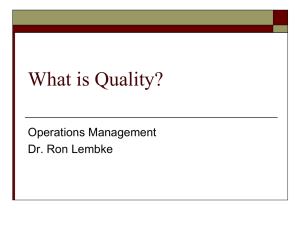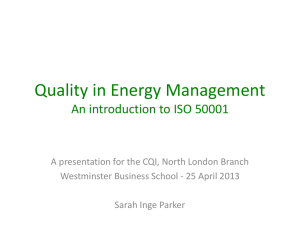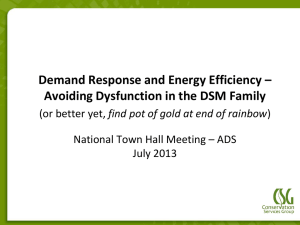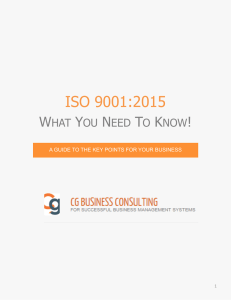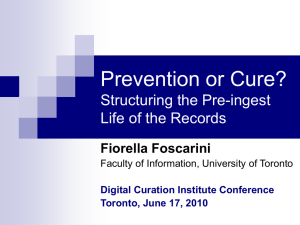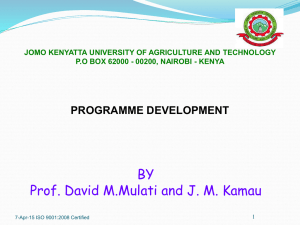Sentence case title
advertisement
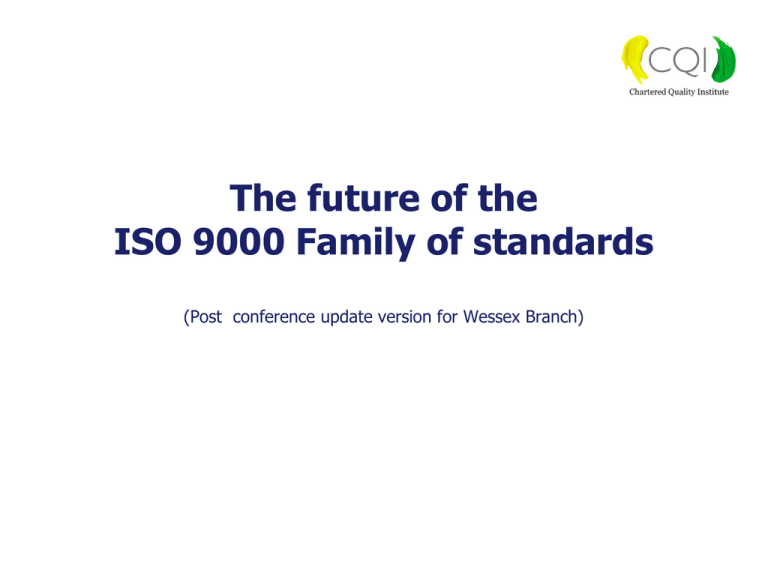
The future of the ISO 9000 Family of standards (Post conference update version for Wessex Branch) Survey replies & analysis 250 people responded out of a mailing of 15,000 Analysis carried out at 150 replies then later at 200 – the results stabilising at 250. 68% were direct users (i.e. not consultants or Auditors) 75% comply with 9001, with 70% saying scope covered all functions 60% with engineering background 2 Usage & perception 90% have read ISO 9000 99% have read ISO 9001 58% have read ISO 9004 With 44% of these reading it as part of a course (so only 29% of total have read without compulsion) 9% used the self assessment in 9004 84% described a QMS as “the way we manage the business” 23% of auditors said it was a ‘description’ 3 Benefits 84% claimed improvements as a result of 9001 46% claimed it had reduced 2nd party audits 64% said ISO 9001 was helpful in understanding and managing business processes. 75% disagreed that it hinders the development of a quality culture 4 Change? 62% said don’t change ISO 9000 42% said don’t change ISO 9001 64% said don’t change ISO 9004 5 432 Recommendations Simplify vocabulary, language, jargon Extend requirements Misunderstood provisions Improve structure of standards Better alignment/integration Recommendation out of scope Additional guidance needed Reduce requirements Improve concepts and principles Change wording More or better pictures needed Improve ISO's Standards System Already addressed in the standard More cross referencing 0% 5% 10% 15% 20% 25% 30% 6 Draft CQI Position Paper 7 Proposition 1 ~ Continued development • Supports continued development of the ISO 9000 family of standards • Encourages a move towards a single management system standard with separate standards for use in assessing capability in areas such as quality, environment, etc.; • Opposes the proliferation of ISO 9001 derivatives that embody ISO 9001 requirements in their entirety; • Supports the development of other management system standards providing they adopt common principles and vocabulary; • Suggests that the revision cycles of ISO 9000, ISO 9001 and ISO 9004 are harmonised and that ISO 9000 become a leading rather than a lagging standard • Suggests that more is done to promote ISO 9000 and ISO 9004 through a more favourable pricing structure and bundling offers. 8 Proposition 2 ~ Introduce fundamental concepts in ISO 9000 1/2 • Organization purpose - purpose needs to be outwardly looking towards society • The external environment - must adapt to the environment for it to survive and achieve its aims • Management systems - one system of management for accomplishing its mission • The importance of stakeholders - organizations and individuals they depend upon for their success • The importance of quality - quality needs to be the first priority • Quality management - Providing the organization with the capability of delivering the required outputs • Achieving quality - depends upon the organization possessing competent people, capable processes and adequate resources. 9 Proposition 2 ~ Introduce fundamental concepts in ISO 9000 2/2 Role of standards • to assist customers translate their needs into common product quality requirements that will ensure uniform acceptance criteria (Product standards e.g. ISO 12944) • to assist organizations develop, operate and maintain effective management systems (Guidance standards e.g. ISO 9000 & ISO 9004) • to enable customers to acquire a level of confidence in a supplier’s capability (Assurance standards e.g ISO 9001, ISO 10012) • to assist customers in assessing the capability of potential suppliers (Assessment standards e.g. ISO 19011) 10 Proposition 3 ~ Extend and amend the quality management principles in ISO 9000 1/1 1. Customer focus 2. Quality first (New) 3. Leadership 4. Involvement of people 5. The process approach (Amended) 6. The systems approach to management (Amended) 7. Improvement (Amended) 8. The factual approach 9. Mutually beneficial relationships (Amended) 10. Assurance (New) 11. Control (New) 12. Agility ? 11 Quality first principle To ensure productivity, safety, efficiency and effectiveness the quality of work must be the number one priority at all levels. An organization applying the quality first principle will be one in which people: • can be trusted to supply the required outputs of the required quality on time; • find the best value solutions that fulfil the requirements; • are authorised to stop a process that is going out of control; • don’t compromise on the quality of work in return for short term gain; • do what they say when they say they will do it; • act ethically and with transparency in what they do to build trust; • are aware of what they do to others and Society generally and manage any risk of the impact of their outcomes before they become a reality. 12 Assurance principle The need for confidence in the integrity of the provisions made to create and supply products increases in proportion to the complexity of organizations and their products. An organization applying the assurance principle will be one in which managers: • understand the requirements the organization is under obligation to satisfy; • understand the complexity of the plans for meeting these requirements; • confirm that these plans, if followed, will deliver outputs that meet the requirements; • decide the level of assurance required on the basis of the risks that will be encountered in implementing these plans • gather objective evidence that plans are being followed; • gather objective evidence that requirements are being met 13 Control principle To adhere to a standard, prevent change or stay on course work needs to be under control and this only arises when variation from prescribed standards is managed within agreed limits An organization applying the control principle will be one in which people: • are not held accountable for results over which they have no control; • decide what needs to be controlled on the basis of what is important for the organization to meet the needs of its stakeholders; • develop or choose units of measure for the parameters to be controlled; • establish or choose a standard level of performance that is consistent with the organization’s objectives etc…….. 14 Amended principles • Process approach - Objectives can be achieved more effectively and efficiently at any level if the work to achieve them is managed across the organization regardless of the functions or levels of those involved in executing the work. • Systems approach - By managing the organization as a system of interacting interdependent variables, outcomes consistent with stakeholder needs are more likely to be produced. • Mutually beneficial relationships - Every organization depends on the support of its investors, customers, employees, suppliers and the community to achieve its strategic objectives and needs to foster a mutually beneficial relationship in exchange for the risks they bear. 15 Proposition 4 ~ Re-structure the ISO 9000 family of standards Either consolidate ISO 9000, ISO 9001 and ISO 9004 into one standard, include a guide to the use and application of the requirements of ISO 9001 and rewrite ISO 9004 as a guide to quality management system development or a) Invoke ISO 9000 in clause 5.1 of ISO 9001 so that it makes the concepts and principles in ISO 9000 part of the assessment criteria b) Split ISO 9000 into 3 parts covering fundamental concepts and principles, a guide to quality management system development and a vocabulary c) Reference all the guides in the family within ISO 9000 in the context in which they are to be used. d) Split ISO 9001 in to 2 parts one being the requirements and the other a guide to the use and application of the requirements 16 Proposition 5 ~ Align ISO 9001 with its purpose The original intent of the ISO 9001 design specification should be re-enforced and the following changes implemented: • The title should be changed to Quality Management Systems - Requirements for Quality Assurance making clear the intended use of the standard. • The purpose and scope statements should be retained but the requirements amended so that they are expressed as results to be achieved and demonstrated rather than actions to be undertaken. 17 Proposition 6 ~ Promote better use of vocabulary • The terms that are fundamental to understanding ISO 9001 should be defined within ISO 9001 • Commonly used business terms should be introduced within the associated notes of a definition to enable users to better understand the context. • An up to date vocabulary database should be maintained on the ISO Web site for use by standards writers and users. 18 Proposition 7 ~ Promote use of ISO 9000 In order to promote better use of ISO 9000 it is proposed that • the term “systems” is removed from the title and scope of ISO 9000 • that guidance on the selection and use of each standard in the ISO 9000 family is introduced • that rules are established that prohibit multiple definitions of the same term in the same context. 19 What now? • • • • • • • • • • Get consensus of Project team Get SDG approval Get PPB approval Present to BSQ QS/1 Agree need for revision of principles by end of March 2011 Define revised principles by end of June 2011 New draft principles by end of December 2011 Agree need to revise ISO 9001 by end of June 2011 Agree ISO 9001 Design Spec by mid 2012 Complete drafting process by mid 2015 20

